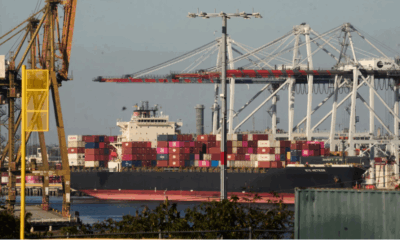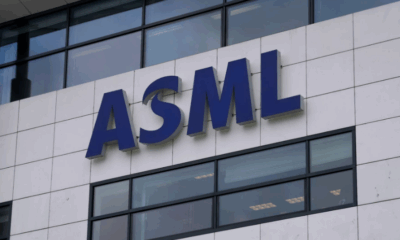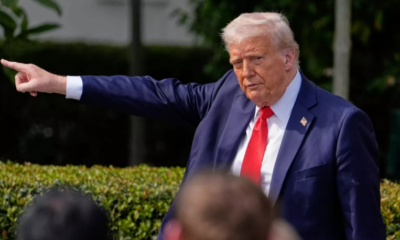Business
ASML Reports Strong Q4 Results Amid Semiconductor Market Turmoil
Dutch semiconductor giant ASML has reported robust fourth-quarter and full-year 2024 earnings, highlighting strong demand in the artificial intelligence (AI) and semiconductor industries despite rising competition from China’s DeepSeek.
Steady Revenue Growth Despite Market Challenges
ASML’s total net sales for 2024 reached €28.3 billion, marking an increase from €27.6 billion in 2023. The company attributed this growth to rapid advancements in AI, which have fueled higher semiconductor demand. However, net income declined slightly to €7.6 billion from €7.8 billion the previous year. Following the earnings report, ASML’s stock surged 10.45% on Wednesday morning.
Surge in Net Bookings
A key highlight of ASML’s performance was the surge in net bookings, which rose to €7.1 billion in Q4 2024, up from €2.6 billion in the previous quarter. This increase was primarily driven by strong demand from Taiwan Semiconductor Manufacturing Company (TSMC). Bookings for extreme ultraviolet lithography (EUV) technology, which is essential for producing smaller and more powerful chips, accounted for €3 billion of the total. ASML remains the only company capable of producing EUV systems.
However, net bookings for the full year declined to €18.9 billion from €20 billion in 2023, reflecting uncertainties in the global semiconductor market.
Optimistic Outlook for 2025
Looking ahead, ASML forecasts first-quarter 2025 net sales between €7.5 billion and €8 billion, with a gross margin between 52% and 53%. For the full year, ASML expects total net sales to range between €30 billion and €35 billion, with gross margins between 51% and 53%.
CEO Christophe Fouquet emphasized AI’s role in driving the industry’s growth: “The growth in artificial intelligence is the key driver for our industry. It has created a shift in market dynamics, presenting both opportunities and risks.”
Analyst Reactions: Confidence in ASML’s Future
Analysts reacted positively to ASML’s results. Ben Barringer, technology analyst at Quilter Cheviot, described the earnings as “impressive,” noting that revenue exceeded forecasts by 2.5%, and profits surpassed expectations by 8%. ASML is forecasting 15% growth in 2025, which Barringer believes underscores confidence in semiconductor demand.
Despite concerns over China’s DeepSeek and declining sales in the Chinese market—which dropped from 47% to 27% quarter-over-quarter—ASML has offset losses with strong demand from South Korea and the US.
DeepSeek’s Disruptive Impact on the AI and Semiconductor Market
The rise of DeepSeek, a Chinese AI-powered chatbot, has intensified market concerns. Since its January 20 release, the app has become the most downloaded free app on the US Apple Store, surpassing OpenAI. DeepSeek claims its AI models match or outperform US rivals in tasks like coding and mathematics while being significantly cheaper and more efficient in semiconductor use.
This development has raised fears for industry leaders like Nvidia, which recently suffered the largest single-day loss in US stock market history, losing nearly $600 billion in market value. Additionally, DeepSeek’s emergence has reignited concerns over the US’s inability to curb China’s AI advancements.
Waiting to See the Long-Term Impact
While ASML’s Q4 results have helped alleviate concerns in the semiconductor market, uncertainty remains regarding how DeepSeek’s rise will shape future demand. Russ Mould, investment director at AJ Bell, acknowledged ASML’s strong earnings performance but warned that AI innovation from China could disrupt industry demand by 2026.
“While ASML is positive about its 2025 outlook, it will take time to see if DeepSeek’s impact will alter demand for advanced chips. If AI development becomes cheaper and more efficient, it could pose challenges for ASML and other semiconductor firms.”
Despite these uncertainties, ASML’s solid order book and strategic positioning in advanced semiconductor manufacturing suggest resilience in a rapidly evolving industry. The coming months will be crucial in determining whether ASML can sustain its momentum amid shifting market dynamics.
Business
DHL Express to Suspend High-Value Consumer Shipments to U.S. Amid Regulatory Changes

DHL Express, the international courier division of Germany’s Deutsche Post, announced it will temporarily suspend global business-to-consumer (B2C) shipments valued over $800 to individuals in the United States starting April 21. The move comes in response to new U.S. customs regulations that have extended clearance times for incoming goods.
According to a notice published on the company’s website, the suspension affects only shipments above the $800 threshold sent to private individuals. Business-to-business (B2B) shipments will continue but may experience delays due to the new processing requirements. Shipments under $800, whether destined for individuals or businesses, remain unaffected.
The change follows an April 5 update to U.S. customs rules, which now require formal entry processing for all imports valued over $800. Previously, this threshold stood at $2,500. DHL cited the revised policy as the reason for the temporary suspension, as the additional paperwork and procedural requirements have significantly slowed customs clearance.
“This is a temporary measure,” the company stated, without specifying when services might resume.
While the announcement was undated, online metadata indicates it was compiled on Saturday. The update marks a significant shift for international logistics companies that rely on streamlined processes to handle high-volume e-commerce shipments.
DHL’s decision comes amid rising trade tensions and shifting import policies in the United States, particularly concerning packages from China and Hong Kong. Last week, Hongkong Post suspended sea mail services to the U.S., accusing Washington of “bullying” after the United States revoked duty-free trade provisions for packages from the region.
In response to earlier inquiries from Reuters, DHL emphasized its commitment to compliance, saying it would continue processing shipments from Hong Kong “in accordance with the applicable customs rules and regulations.” The company also said it is working with customers to help them adapt to the upcoming changes, particularly those set to take effect on May 2.
Industry analysts say the new U.S. customs policy could have a wide-reaching impact on cross-border e-commerce, as formal entry requirements typically involve additional documentation, processing fees, and longer delivery times. Retailers and logistics firms alike are now reassessing their operations to minimize disruption for customers.
DHL has not provided a specific date for when high-value B2C shipments to the U.S. will resume but indicated that the pause is a precautionary response to the evolving regulatory environment.
Business
Trump Administration Imposes New Fees on Chinese Ships, Escalating Trade Tensions
The Trump administration on Thursday announced new fees targeting Chinese-built and Chinese-owned vessels docking at U.S. ports, escalating the ongoing trade war between Washington and Beijing. The move is aimed at countering China’s growing dominance in the global shipbuilding industry and protecting U.S. maritime interests.
The announcement, made by the Office of the United States Trade Representative (USTR), follows a year-long investigation launched under the Biden administration into China’s shipbuilding practices. USTR Ambassador Greer said the decision is designed to “begin to reverse Chinese dominance, address threats to the U.S. supply chain, and send a demand signal for U.S.-built ships.”
The new policy will introduce fees based on net tonnage per voyage for Chinese-built and owned vessels entering U.S. ports. This first phase is set to take effect in 180 days. A second phase, targeting foreign-owned liquefied natural gas (LNG) vessels built in China, will be implemented within three years.
The fees could reach as high as $1 million for each Chinese-built ship and $1.5 million for foreign-owned carriers with Chinese-built vessels in their fleets, according to findings from the USTR investigation. The move marks a significant shift in maritime trade policy, as the U.S. seeks to reduce its dependency on Chinese-made ships.
The USTR probe, launched in April 2024 under Section 301 of the 1974 Trade Act, was prompted by a petition from five national labor unions raising concerns over China’s increasing control over global shipping. The USTR concluded that China’s practices unfairly displaced foreign competitors and reduced global competition in maritime logistics.
China currently dominates the global shipbuilding market, with Chinese-built vessels accounting for 81% of the total market share in 2024. In the energy sector, China controls 48% of the liquefied petroleum gas (LPG) vessel market and 38% of the LNG sector, according to Veson Nautical.
In response to last year’s proposal, China’s Ministry of Commerce criticized the U.S. investigation as “a mistake on top of a mistake.” However, no official statement has been issued following the latest U.S. policy announcement.
Despite the new maritime fees, President Trump appeared to signal a pause in further tariff hikes. Speaking to reporters, he said, “At a certain point, I don’t want [tariffs] to go higher because… you make it where people don’t buy.” Trump indicated he may lower existing tariffs to avoid further disruption in trade flows.
Currently, the Trump administration has imposed tariffs of 145% on all Chinese imports, while China has retaliated with 125% tariffs on U.S. goods. In response, Beijing has hinted at shifting its countermeasures to the U.S. services sector, including legal consultancy, tourism, and education.
As tensions continue to rise, the shipping fee move represents a broader effort by Washington to reshape global trade and strengthen domestic manufacturing — though it risks inflaming economic ties with China even further.
Business
Global Luxury Sector Faces New Blow as US-China Trade War Escalates
The global luxury industry, already grappling with declining demand and changing consumer habits, faces a new hurdle as the trade war between the United States and China intensifies. Analysts warn that the sector’s fragile recovery may be further threatened by President Donald Trump’s recent decision to hike tariffs on Chinese goods to as high as 245%.
According to a memorandum seen by Euronews, the luxury market is forecasted to grow modestly at 1% to 3% annually between 2024 and 2027. This is a sharp slowdown compared to the 5% yearly growth seen between 2019 and 2023, and 9% between 2021 and 2023, as highlighted in a report by McKinsey.
China and the US are two of the largest luxury markets globally. In 2023, China accounted for 22%–24% of global luxury consumption, while US consumers contributed around 21% of total revenue in 2024, according to Bain & Company and Bank of America. Popular products in both markets include handbags, cosmetics, footwear, and leather goods, with brands such as Chanel, Dior, Louis Vuitton, Gucci, and Prada dominating sales.
However, economic slowdowns in both countries, combined with rising inflation and interest rates, have already caused luxury shoppers to scale back. The cost of living crisis in several regions has shifted consumer preferences toward more durable and budget-conscious purchases. Furthermore, luxury brands that raised prices post-pandemic without matching innovation are losing their exclusivity appeal.
The latest round of US tariffs, coupled with retaliatory Chinese tariffs currently at 125%, have added fresh uncertainty to the sector. Global stock markets have responded negatively, wiping billions in market capitalization from luxury giants. Shares of Lululemon Athletica dropped 20.7% on Nasdaq, Prada Group fell 23.4% on the Hong Kong Stock Exchange, and Kering and LVMH declined 26.3% and 19.9% respectively on Euronext Paris.
LVMH, often seen as a bellwether for the luxury industry, reported a 2% dip in Q1 2025 revenue to €20.3 billion. Fashion and leather goods revenue dropped 4%, perfumes and cosmetics remained flat, and wines and spirits fell 8%. Only watches and jewelry showed growth with a modest 1% increase.
Beyond China, US tariffs on EU goods—although reduced to 10% temporarily—also pose risks. The US imports various luxury products from Europe, including wine, chocolate, high-end apparel, and cars. These tariffs could increase prices for American consumers, potentially leading to reduced spending.
Additionally, the fragmented and globalized supply chains of luxury brands may incur hidden costs due to tariffs, further squeezing margins and complicating logistics.
In a surprising twist, the rising cost of luxury imports has led some Chinese manufacturers to promote knock-off products directly to US consumers via platforms like TikTok. Claiming to be original equipment manufacturers, they offer imitations of products like Birkin bags and Lululemon leggings at steep discounts. While their claims are largely unverified, Chinese wholesale platform DHgate has surged to the number two spot on the US Apple App Store, signaling growing consumer interest in alternatives amid rising prices.
As trade tensions deepen, the luxury sector is bracing for further disruptions in an already turbulent market landscape.
-

 Business11 months ago
Business11 months agoSaudi Arabia’s Model for Sustainable Aviation Practices
-

 Business11 months ago
Business11 months agoRecent Developments in Small Business Taxes
-

 Politics11 months ago
Politics11 months agoWho was Ebrahim Raisi and his status in Iranian Politics?
-

 Business10 months ago
Business10 months agoCarrectly: Revolutionizing Car Care in Chicago
-

 Business10 months ago
Business10 months agoSaudi Arabia: Foreign Direct Investment Rises by 5.6% in Q1
-

 Technology11 months ago
Technology11 months agoComparing Apple Vision Pro and Meta Quest 3
-

 Politics11 months ago
Politics11 months agoIndonesia and Malaysia Call for Israel’s Compliance with ICJ Ruling on Gaza Offensive
-

 Technology11 months ago
Technology11 months agoRecent Developments in AI Ethics in America


























